Savanna Henning, Biological Sciences Technician, National Parks Service, on Beavers and Floodplain Forest Resiliency
 Friday, November 11, 2022 at 3:31AM |
Friday, November 11, 2022 at 3:31AM |  Becky Fillinger |
Becky Fillinger | Article by Becky Fillinger
The beaver is a keystone species - a species on which other species in an ecosystem largely depend, and if they are removed, the ecosystem would change drastically. The busy work of beavers can be highly beneficial and conversely detrimental to our local wetlands’ landscapes. We talked to Savanna Henning, Biological Sciences Technician for the Mississippi National River and Recreation Area, about a three-year study being conducted on beavers and the floodplain forest - and how you may volunteer to be part of the project.
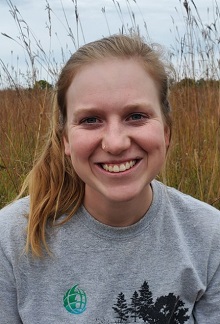 Savanna HenningQ: Please tell us about your research work with beavers and floodplain management.
Savanna HenningQ: Please tell us about your research work with beavers and floodplain management.
A: The Mississippi National River and Recreation Area, Mississippi Park Connection and the University of Minnesota are conducting a 3-year floodplain forest resiliency partnership study to better understand the relationship between beaver and floodplain forest plant communities. This collaborative team received a grant this summer from the Legislative-Citizen Commission on Minnesota Resources (LCCMR) which will provide funding for the study through 2025, with goals of continued research going forward.
Anecdotal evidence has shown that beaver presence on the river affects sapling trees' - specifically the mighty cottonwood trees' - ability to grow to full maturity. This study seeks to quantify the impact of beavers on floodplain forest plant communities and allow the park service and partners to develop a set of best management practices for effective and efficient floodplain forest restoration. To date, an initial beaver activity survey has been conducted around and along the 72-mile stretch of Mississippi River that runs through Minneapolis and St. Paul. This survey documented beaver signs including dams, food caches and foraging trails, as well as inactive and active lodges and dens. The data from the survey will provide a starting point for developing a monitoring plan. This fall, wildlife technicians have begun deploying a series of wildlife cameras on active lodges and dens throughout the corridor to assist in determining colony size, observe possible predator-beaver interactions and select appropriate sites for vegetative tree surveys in the following years.
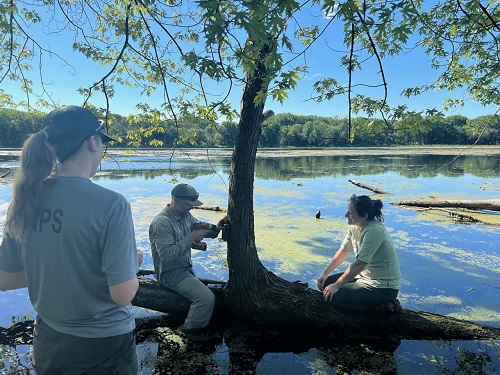 Current and former National Park Service Biological Science Technicians Savanna Henning and Bridgette Timm and University of Minnesota ecologist Dr. Joseph Bump deploy a beaver wildlife camera near a lodge at Crosby Farm in St. Paul.
Current and former National Park Service Biological Science Technicians Savanna Henning and Bridgette Timm and University of Minnesota ecologist Dr. Joseph Bump deploy a beaver wildlife camera near a lodge at Crosby Farm in St. Paul.
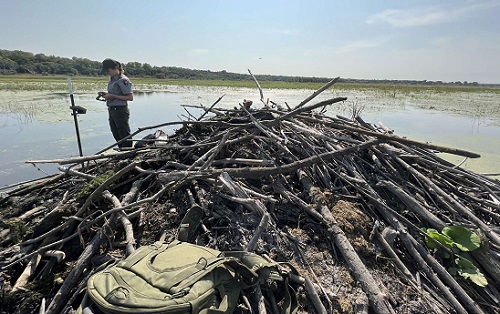 Biological Science Technician Savanna Henning checking a beaver wildlife camera on a lodge at Ft. Snelling State Park.
Biological Science Technician Savanna Henning checking a beaver wildlife camera on a lodge at Ft. Snelling State Park.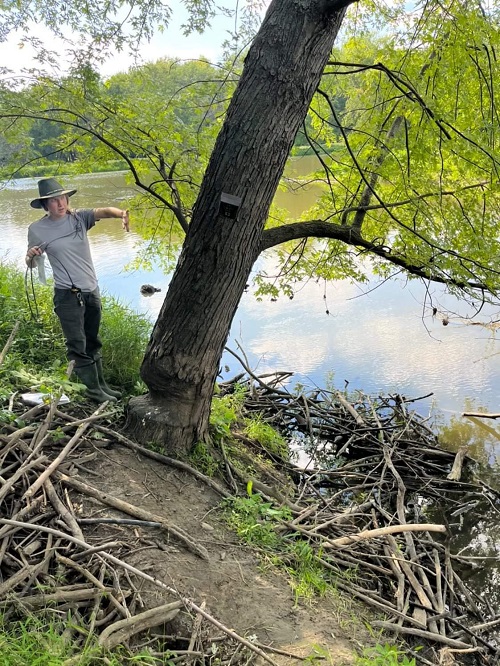 Biological Science Technician Savanna Henning talking about the goals of the wildlife cameras on and near beaver bank dens and lodges.
Biological Science Technician Savanna Henning talking about the goals of the wildlife cameras on and near beaver bank dens and lodges.Q: How do beavers help to control floods? How does beaver activity affect sapling tree survival rates?
A: Known as nature's architectural engineers, beavers have the incredible ability to shape ecosystems by a multitude of behaviors including crafting and maintaining dams, burrowing in riverbanks and feeding and use of tree species. Many studies have found that beavers impact the hydrology of rivers and streams by slowing down and spreading out water into floodplain habitats, which may reduce the impact of floods but is largely dependent on context. Though this 3-year floodplain forest resiliency study does not directly aim to answer questions of beavers and flooding in the Mississippi corridor, it may lead to future questions surrounding beavers and flooding. The aim of the study is to explore the effect beaver activity has locally on sapling tree survival rates. The specific sapling tree species of interest for the study is the eastern cottonwood tree which can grow to heights of 100 feet, contributing to soil stabilization, carbon storage and wildlife habitat. This tree is also well known for the large amounts of water that it uses, an average of 50-200 gallons/day, directly linking it to the water cycle in our park. It certainly wouldn't be science if one study did not open up the flood gates to a multitude of new questions!
Q: Will the public be able to watch the beaver activity from the wildlife cameras your team is installing? How do we follow news of this project?
A: As of this fall, there is not a livestream wildlife camera available for the public to watch, though there is discussion of one in the future! We will be processing beaver footage collected after the field season. Look to Mississippi National River and Recreation Facebook page for opportunities to view videos captured by beaver cams and receive updates on the project in the next few years! You can also look to the Science and Research page on the Mississippi National River and Recreation website for updates.
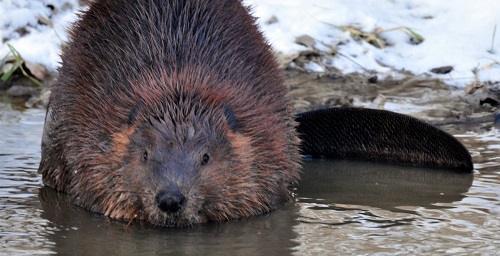
Q: Thank you for this important work. Do you need volunteers?
A: The park is encouraging visitors to report any beaver activity they see within the parks borders, which can include fallen trees due to chewing, beaver dams, tracks, lodges, bank dens and of course sightings, to contribute to this body of research. It may be surprising that beavers are present even in the main channel of the Mississippi, but they are certainly there! Along large rivers they often inhabit bank dens which are much less conspicuous than the iconic beaver lodge.
To report any of the described beaver signs visit https://parkconnection.org/beaver. Volunteers are also needed to assist with beaver wildlife camera work and can find upcoming opportunities at parkconnection.org/volunteer and scroll down to find the volunteer opportunity entitled "Beaver Monitoring Assistant."
